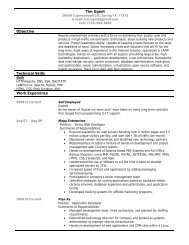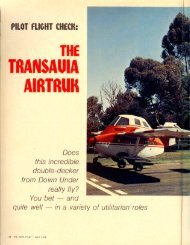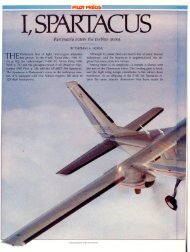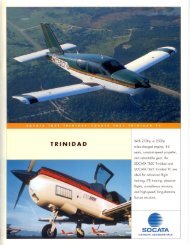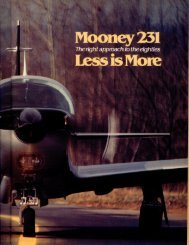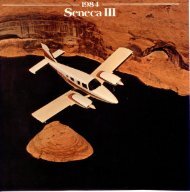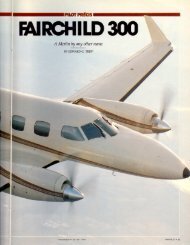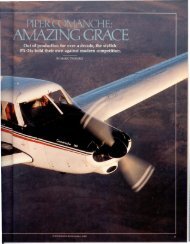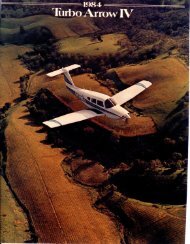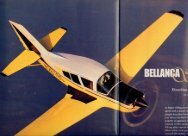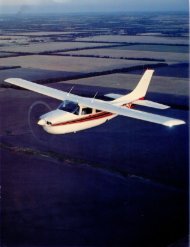Schweizer Sprite - Aero Resources Inc
Schweizer Sprite - Aero Resources Inc
Schweizer Sprite - Aero Resources Inc
Create successful ePaper yourself
Turn your PDF publications into a flip-book with our unique Google optimized e-Paper software.
I<br />
tion with the surface, wind velocity diminishes<br />
the more you descend for<br />
your touchdown. At 150 feet agl you<br />
may have a 26 knot headwind; at 50<br />
feet the wind could drop to only 10<br />
mph. To compensate for this wind gradient<br />
effect, you need extra airspeed to<br />
protect against a wind-shear-induced<br />
stall close to the ground.<br />
Holding 52 knots in the pattern,<br />
look over at the vertical velocity indicator<br />
(VVI) and then pop open the<br />
spoilers. Instantly you hear the whoosh<br />
of the disturbed airflow and see a<br />
l,OOO-fpm descent rate. Close the<br />
spoilers and see the VVI return to its<br />
normal 400-fpm descent rate. The<br />
spoilers-and slipping-are the key to<br />
the proper approach profile. Remember<br />
that there will be no go-arounds.<br />
The spoilers must be played<br />
throughout the approach, but the judgment<br />
needed to achieve the proper,<br />
J<br />
t<br />
~ I<br />
t<br />
.,..<br />
t /t"Y'v ". "<br />
fL'/ ,fi, i<br />
rJ lit<br />
\' .1 A<br />
\I ••.;;i 1 1,/ /~~ ~. ' ~,<br />
~~<br />
',X 'I'<br />
• __ t<br />
steep angle of descent comes easily to<br />
most power pilots. I am cautioned to<br />
stay high. A too-high situation can be<br />
corrected quickly by slipping with<br />
spoilers extended; but if- you are too<br />
low, well old boy, it's just poor form.<br />
The flare does not take much aft<br />
stick pressure at all. Gill says that<br />
many power pilots flare too high then<br />
drop the glider in. The flare, I am told,<br />
should come at about five feet or so<br />
above the surface. With the spoilers<br />
deployed, you will have no trouble<br />
bleeding off airspeed, and, after a<br />
while, spot landings become routine.<br />
If you want to dramatically shorten<br />
your ground roll, you can do what I did<br />
the first time. Pulling all the way back<br />
on the spoiler control engages the<br />
wheel's disc brake. When you land<br />
with the brake on, you do not "roll"<br />
very far; take my word for it. The deceleration<br />
is impressive, and those<br />
Along the top row, from left to righi. are the A. B, C silver. gold and triple-diamond badges.<br />
The "N" means that the pilot is an American. Lennie pins are arranged along the bollom row.<br />
in a mountain wave. A flight between<br />
35,000 and 40,000 feet earns a twolennie<br />
pin, and d climb above 40,000<br />
feet warrants a three-Jennie pin.<br />
Those with a competitive nature may<br />
want to break a state, national or world<br />
sailplane record. But unless intensely<br />
motivated and extraordinarily experienced,<br />
pilots should shy away from assaulting<br />
world records. After all, how<br />
many pilots are capable of soaring above<br />
46,267 feet mean sea level, the altitude<br />
!hat was attained in 1961 by Paul Bikle,<br />
piloting a <strong>Schweizer</strong> SGS-123E sailplane.<br />
This lofty mark is well above the<br />
maximum-authorized altitude of any<br />
Boeing jetliner.<br />
Other impressive world marks are<br />
Hans Werner Grosse's nonstop, straightline<br />
flight of 788.8 nautical miles and<br />
Klass Goudriann's average speed of<br />
94.5 knots around a 100-kilometer<br />
,,<br />
(53.4 nautical miles), triangular course.<br />
Those desirous of hurdling less forbidding<br />
obstacles might set their sights on<br />
one of the 80 different records listed for<br />
each of the 50 states. Although many of<br />
these state records represent remarkable<br />
achievements, many others have yet to<br />
be established and pose much less of a<br />
challenge. For example, not one soaring<br />
record has been set in either Alaska<br />
(which, admittedly, is not a popular<br />
soaring site) or South Dakota.<br />
For whatever reasons, neither SSA nor<br />
FAI have yet to recognize equality of the<br />
sexes formally. Each has a separate listing<br />
for women's records.<br />
A complete summary of all soaring<br />
records is published in SSA's current<br />
membership handbook. It is available<br />
from the society by sending $5 to Post<br />
Office Box 66071, Los Angeles, California<br />
90066. -Barry Schiff<br />
four-point, glider safety harnesses (every<br />
airplane should be made to have<br />
them) came in handy. I was afraid I<br />
might have damaged the glider; but instead<br />
[ was told that the practice of<br />
landing with the brake on is acceptable<br />
under certain conditions. It does not do<br />
those brake pads any good, though.<br />
There were four dual flights the first<br />
day and three more the next. On the<br />
last one, Gill pulled the tow release at<br />
250 feet agl, simulating a low-altitude<br />
rope break. Even at that low altitude, a<br />
180-degree turn to a downwind landing<br />
is still possible.<br />
The next three flights that day were<br />
solo. For the most part, they were uneventful,<br />
except that I did gain 1,000<br />
feet above release altitude one time,<br />
and, occasionally, I wound up laughing<br />
and talking to myself. The transformation<br />
from power- to sailplane-mentality<br />
had been so fast, and yet so casual,<br />
that it somehow was laughable to be<br />
engineless and not worried.<br />
Just about the time [ was starting to<br />
get attached to the 2-33, they put me<br />
into the Model 1-26, a much sleeker<br />
single-seater. Now we're getting somewhere,<br />
I thought. The 1-26 looked<br />
fast, and the thought of just one seat<br />
conjured up a Ferrari-dream I once had.<br />
The preflight briefing for my first 1<br />
26 flight consisted of the recitation of a<br />
few cardinal airspeeds and warnings<br />
about the responsiveness of the controls.<br />
But for all practical purposes, the<br />
1-26 behaves much like a 2-33. It was,<br />
after all, designed for an easy transition<br />
to higher-performance soaring. On<br />
tow, your workload goes up because<br />
the extra responsiveness keeps you<br />
jockeying when you fly at the towplane's<br />
57 knots. But the I-26's thermal,<br />
best lift/drag and landing speeds<br />
are only a few miles an hour faster<br />
than the 2-33's. Even so, I did not feel<br />
that the controls were all that touchy.<br />
There is always a lag between the time<br />
you make an input and the time something<br />
happens.<br />
Stall a 1-26, though, and you will<br />
discover a big difference between it and<br />
a 2-33. At the stall, there will be an<br />
unmistakable break, and a wing always<br />
will drop. The 1-26 also will spin quite<br />
readily. Once you have started spinning,<br />
you must remember that, because<br />
the 1-26 is sleek, it will build up plenty<br />
of airspeed very fast, if too much<br />
forward stick is applied to break the<br />
stall. Then you are in the unenviable<br />
position of being aimed straight down,<br />
AOPA PilOT· 39


